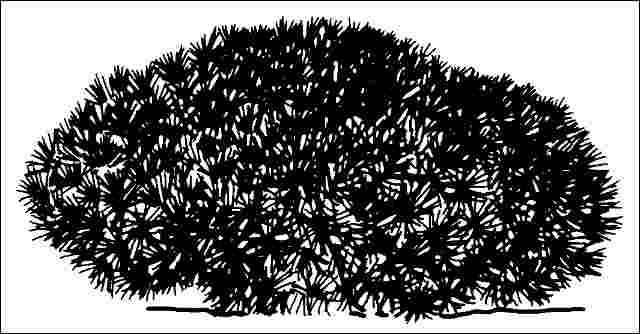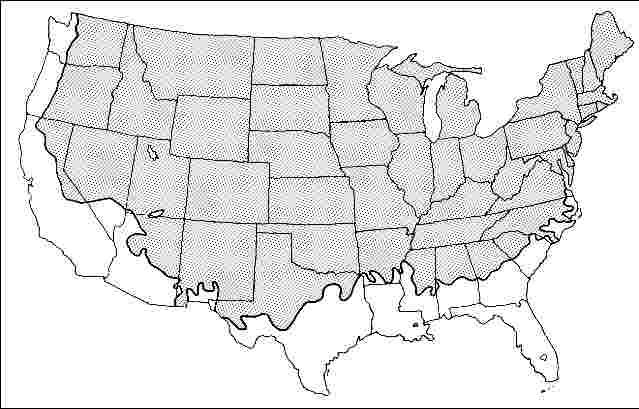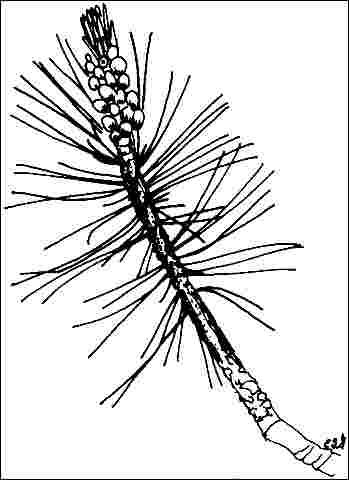Introduction
Mugo pine is a shrub or small, round or broad pyramidal plant 4 to 10 feet tall which grows best in sun or partial shade in moist loam. Needles of this two-needle pine are held on the tree for more than four years making this one of the more dense pines suitable for a screen planting. Most other pines are not suited for screens since they loose their inner needles and lower branches as they grow older. Since there seems to be great variability in height among individual trees, select nursery plants which have the form which you desire. When selecting a mugo pine to grow into a tree, choose one with a central leader; if looking for a more dwarf type mugo pine choose among the many compact selections.

General Information
Scientific name: Pinus mugo
Pronunciation: PIE-nus MEW-go
Common name(s): Mugo pine, Swiss Mountain pine
Family: Pinaceae
USDA hardiness zones: 2A through 7B (Fig. 2)
Origin: not native to North America
Invasive potential: little invasive potential
Uses: screen; container or planter; bonsai; highway median; Christmas tree
Availability: not native to North America

Description
Height: 15 to 25 feet
Spread: 15 to 25 feet
Crown uniformity: symmetrical
Crown shape: round, pyramidal
Crown density: dense
Growth rate: slow
Texture: fine
Foliage
Leaf arrangement: alternate (Fig. 3)
Leaf type: simple
Leaf margin: entire
Leaf shape: needle-like (filiform)
Leaf venation: parallel
Leaf type and persistence: fragrant, evergreen, needled evergreen
Leaf blade length: less than 2 inches
Leaf color: green
Fall color: no color change
Fall characteristic: not showy

Flower
Flower color: yellow
Flower characteristics: not showy
Fruit
Fruit shape: oval, cone
Fruit length: 1 to 3 inches
Fruit covering: dry or hard
Fruit color: brown
Fruit characteristics: does not attract wildlife; not showy; fruit/leaves a litter problem
Trunk and Branches
Trunk/bark/branches: branches don't droop; not showy; typically multi-trunked; thorns
Pruning requirement: little required
Breakage: resistant
Current year twig color: green, brown
Current year twig thickness: medium
Wood specific gravity: unknown
Culture
Light requirement: full sun, partial sun, or partial shade
Soil tolerances: clay; sand; loam; alkaline; acidic; well-drained
Drought tolerance: moderate
Aerosol salt tolerance: high
Other
Roots: not a problem
Winter interest: no
Outstanding tree: no
Ozone sensitivity: unknown
Verticillium wilt susceptibility: resistant
Pest resistance: resistant to pests/diseases
Use and Management
Trees best recover from transplanting when moved balled and burlapped, not bare-root. It performs remarkably well on soils with a high pH and is fairly well adapted to urban sites. Plant size and density can be controlled by pinching the elongating candles just before or as the needles begin emerging but this is usually not needed on mugo pine since growth is very dense. Pines are deep rooted except on shallow, poorly-drained soil where there will be only shallow roots.
Several cultivars are available: 'Compacta'—rounded, three feet tall; 'Gnome'—about 12 feet tall; 'Hesse'—dwarf; var. mugo—2 1/2 to six feet tall but very broad; var. pumilo—prostrate.
Propagation is by seed.
Pests
Mugo pine is a favored host for pine sawfly and pine needle scale. Some adelgids will appear as white cottony growths on the bark. All types produce honeydew which may support sooty mold. European pine shoot moth causes young shoots to fall over. Infested shoots may exude resin. The insects can be found in the shoots during May. Pesticides are only effective when caterpillars are moving from overwintering sites to new shoots. This occurs in mid to late April or when needle growth is about half developed.
Bark beetles bore into trunks making small holes scattered up and down the trunk. Stressed trees are more susceptible to attack. The holes look like shotholes. Keep trees healthy.
Sawfly larvae caterpillars are variously colored but generally feed in groups on the needles. Some sawfly larvae will flex or rear back in unison when disturbed. Sawflies can cause rapid defoliation of branches if left unchecked.
Pine needle miner larvae feed inside needles causing them to turn yellow and dry up.
Pine needle scale is a white, elongated scale found on the needles. Pine tortoise scale is brown and found on twigs. Depending on the scale, horticultural oil may control overwintering stages.
Pine spittle bug lives and hides in a foamy mass.
Spruce mites cause damage to older needles, and are usually active in the spring and fall. Mites cause older needles to become yellowed or stippled.
Zimmerman pine moth larvae bore into the trunk. The only outward symptoms may be death of parts of the tree or masses of hardened pitch on the branches.
The larvae of pine weevils feed on the sapwood of the leaders. The leader is killed and the shoots replacing it are distorted. First symptoms are pearl white drops of resin on the leaders. The leaders die when the shoot is girdled as adults emerge in August. Prune out and burn infested terminals before July 15.
Pine wilt nematode can kill trees.
Diseases
Diplodia tip blight is a common problem and mugo pine is very sensitive.
This pine is susceptible to rusts. Canker diseases may rarely cause dieback of landscape pines. Keep trees healthy and prune out the infected branches.
Needle cast is common on small trees and plantation or forest trees. Infected needles yellow and fall off.